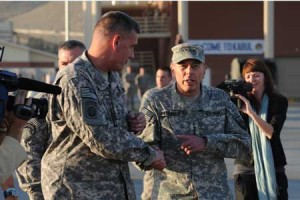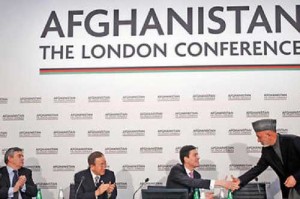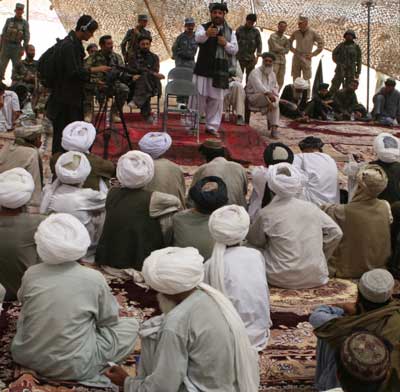One of the challenges General David Petraeus, U.S. Army, faces as the newly appointed commander of U.S. and NATO forces in Afghanistan is the failure of past efforts to induce many of the Taliban guerrillas to defect and some of the Taliban leaders to negotiate a peace settlement with the internationally recognized Kabul government led by President Hamid Karzai. The Afghan government and its foreign backers differentiate between “reintegration” and “reconciliation.” The former concept involves inducing lower-level Taliban fighters to cease fighting and return to civilian life, while reconciliation entails negotiating a political settlement with senior Taliban leaders who are willing to break with al-Qaeda. At the January 2010 London Conference on Afghanistan, foreign governments pledged millions of dollars to support these initiatives, which are seen as complementary to the military operations in ending the fighting since NATO forces and their Afghan government allies cannot expect to kill or capture all the Taliban insurgents.

Karzai has come under increasing pressure this year by war-weary governments to make progress in his domestic reforms in order to strengthen his government against the insurgents. When they met in the Canadian city of Muskoka, the leaders of the Group of Eight industrial countries singled out Afghanistan as one of the major international security issues preoccupying world leaders in their June 26 summit communiqué. Although the G-8 leaders remain united in their opposition to the Taliban, after almost a decade of fighting they are eager to reduce their military, financial, and other costly support for the Kabul government. Reminding Karzai of the many commitments he adopted at the January 2010 London Conference, the G-8 leaders pressed him to assume leadership of the Afghan War. The G-8 summit declaration further called on the Afghan government to “expand the capacity of the Afghan National Security Forces to assume increasing responsibility for security within five years,” adding that “we fully support the transition strategy adopted by International Security Assistance Force contributors in April.” The text also backed Karzai’s efforts to reintegrate defecting Taliban guerrillas and negotiate a political reconciliation with moderate Taliban leaders. In this respect,” it claimed, “the June Peace Jirga was an important milestone.”
Nonetheless, the June 2-4 National Consultative Peace Jirga, billed as a measure to pursue a national consensus on a peace plan, has thus far failed to have much impact on reducing the fighting because the Taliban rejected the process. More than 1,600 delegates tribal elders, religious leaders, and other influential members of Afghan society participated in the three-day assembly, but almost all the attendees were supporters of Karzai or at least opponents of his Taliban adversaries. They discussed the main terms of Karzai’s proposed peace plan, which would demand that Taliban leaders break with al-Qaida, cease military action, and accept the main tenets of the current Afghan constitution. In return, the Afghan government would work with its international partners to remove them from the U.N. terrorist blacklist. The Afghan authorities would also permit some former Taliban leaders to re-enter political life in Afghanistan while others would receive assistance to relocate to a third country.
Until now, the only issue the main Taliban leadership loyal to Mullah Omar has expressed interest in discussing is how rapidly foreign forces will leave Afghanistan. They greeted the inauguration of the Peace Jirga with rocket attacks and suicide bombers. But at some point the Taliban might try to follow the North Vietnamese example and pretend to endorse a peace settlement and democratic principles in order to secure a withdrawal of foreign troops. They then could resume their offensive against Afghan security forces that have yet to establish their military effectiveness, knowing that Western publics would prevent their publics from sending their troops back. The Pakistani Taliban has employed their stratagem in the past, ostentatiously negotiating truces with the military in order to allow their forces to rest and regroup before resuming their attacks shortly thereafter.
Karzai and Western leaders have repeatedly insisted that their reconciliation offer does not extend to al-Qaeda members, who are seen as alien foreign elements whose extremist convictions and past terrorist activities make them unacceptable negotiating partners. Yet, it is unclear whether it will ever be possible to split Taliban leaders from their al-Qaeda allies. The leaders of the two extremist groups share the immediate aim of driving Western troops out of Afghanistan so that they can depose Karzai and reestablish a strict Islamic government in which they enjoy a monopoly of political and religious power. In theory, the two groups profess divergent long-term objections outside of Afghanistan. Taliban representatives insist their political ambitions are confined to Afghanistan, and that they would not support Islamic insurgencies in other countries or support international terrorism. But al-Qaeda leaders continue to declare their goal to be establishing radical Islamist regimes throughout the Muslim world and waging war against a long list of foreign governments that they see as resisting this objective or describe as Muslim oppressors. In any case, it is hard to see how if the Taliban returned to power, it would use force to prevent al-Qaeda from reestablishing its military presence in Afghanistan and using these new base camps to organize additional terrorist attacks in other countries. The Taliban and al-Qaeda fighters in Afghanistan are closely integrated at the operational level, with al-Qaeda members embedded in most important Taliban field operations.
There is much greater international support for efforts to reintegrate lower-level Taliban foot soldiers who may have joined the insurgency for money or other non-ideological reasons. The hope is that they might be induced to desert in return for suitable compensation. Despite some impressions, reintegration involves more than simply giving Taliban members money to cease fighting, which would be a terrific recruiting tool for the insurgents since almost everyone would join their ranks to get funded. Rather, the reintegration process involves providing jobs, vocational training, housing, and other benefits that would allow rank-and-file Taliban insurgents to make a better living than they do now as hired fighters.
In late June, Karzai finally approved his long-discussed reintegration plan. According to the draft plans in circulation at the time of Karzai’s visit to Washington in May, the Afghan government would put many of these ex-fighters in demobilization centers for up to three months, where they would be “de-radicalized” through special classes modeled after those employed in Saudi Arabia and other procedures. They would also receive occupational training in preparation for employment in such fields as construction, farming, tailoring, electrical repairs, and other jobs requiring minimal training and education. A new Engineering and Construction Corps and Agriculture Conservation Corps would employ some former fighters to build national highways, irrigation networks, and other major public infrastructure projects. The government would also pay these ex-guerrillas to help respond to natural disasters, such as floods. Some of the former fighters would be allowed to enroll in the Afghan National Army and Police, despite the risk that they might rejoin the Taliban again after receiving government-funded training and weapons. Karzai’s proposes to create a High Level Peace Council to oversee this reintegration process. Taliban defectors would receive a biometric identification card, with the data shared with the Afghan authorities to discourage defectors from rejoining the insurgency or attempting to reintegrate multiple times to receive additional benefits. The reintegration process would be rolled out gradually, with implementation beginning in the provinces of Kandahar, Helmand, Herat, Baghdis, Nangarhar, Kunduz, and Baghlan. The hope is that any problems with the reintegration strategy would become evident early on, allowing for timely mid-course corrections.
The intent of these and other safeguards is to overcome the problems that undermined the success of previous reintegration efforts. To prevent them from returning to the battlefield, the government must be able to find them suitable alternative employment, protect them from reprisals from either their former government adversaries or their former Taliban allies, and guard against sham defectors seeking to infiltrate its ranks. In past reintegration schemes, many of the former fighters subsequently took up arms again because of implementation problems at the local level. In many cases, the fighters did not receive adequate financial assistance, employment retraining, and protection for their safety, leaving them vulnerable to retaliation from both the Taliban and their former government opponents. Yet, Afghan authorities must not offer so much compensation to their former enemies that those who remained loyal become angered that their fidelity was not rewarded.

At the London Conference, the international community promised to provide hundreds of millions of dollars to support Taliban reintegration. All too often, though, foreign governments have failed to fulfill their pledges with concrete assistance. Another problem is that the years of fighting have left Afghan public institutions so weak that they will find it a challenge to either entice many Taliban fighters to defect or to keep them sufficiently satisfied afterwards that they do not rejoin the insurgency. The high levels of Afghan public corruption will dilute the impact of those foreign pledges of financial assistance that are ever fulfilled. International donors confront the choice of either accepting considerable financial leakage in their funding of reintegration projects or abandoning their efforts pending a change in Afghan cultural practices, which are unlikely to soon change. Citing these weaknesses, foreign donors tend to bypass Afghan government institutions and deal directly with local tribal leaders or other extra-governmental structures, which compounds the problem by limiting their contributions to building Afghan state capacity. In addition, these independent groups suffer from their own capacity and corruption problems. Furthermore, according to Kai Eide, the previous UN Special Representative to Afghanistan, one reason the Taliban insurgency had been spreading throughout Afghanistan is that military priorities have determined international development efforts, resulting in aid flowing to the violent southern provinces, breeding resentment elsewhere among communities that have stayed loyal to the government, rather than being more evenly distributed across the country. Western-supported reintegration projects, many of which will be funded by U.S. military commanders in their localities, will need to encourage Taliban resettlement, employment, and other opportunities throughout Afghanistan. Relocating Taliban defectors to other localities could also decrease their vulnerability to retribution by their former comrades-in-arms.
One reason for the slower than anticipated progress in the reconciliation and reintegration processes is that Western governments have discouraged Karzai from engaging in genuine peace negotiations with Taliban leaders until coalition forces have had the opportunity to reverse the situation on the battlefield. U.S. policy makers in particular want to take advantage of the ongoing surge in NATO combat forces in Afghanistan—which should number about 150,000 by August, of which some two thirds will be American—to shake Taliban commanders’ conviction that they will win the war. The hope is that the reconciliation and reintegration processes will weaken the insurgency sufficiently that the Afghan military — newly enlarged and trained with considerable foreign assistance — will prove adequate to overcoming the remaining hard-liners, even after foreign troops reverse their current surge and scale down their presence during the next few years.
After the G-8 summit, Staffan de Mistura, the U.N. Secretary-General’s Special Representative for Afghanistan and head of the U.N. Assistance Mission in Afghanistan (UNAMA), claimed that the Taliban would be forces to negotiate a peace agreement because they could never defeat the international military forces or win much popular support among Afghans. He acknowledged that the Taliban and their al-Qaeda allies would likely engage in “spectacular types of activities” designed to demonstrate their military capabilities, meaning that, “The end is going to be painful before it gets better.” One fortuitous advantage de Mistura brings to his new assignment is that he led the U.N. mission in Iraq when General. Petraeus led the successful counterinsurgency campaign there. De Mistura optimistically observed that Gen. Petraeus would make “quite a difference” in Afghanistan because in Iraq he had “showed a remarkable capacity of combining military skills with diplomatic sensitivity, cultural sensitivity and political finessing, which is quite a rare combination.”
Shortly after the G-8 summit, however, the Taliban leadership again rejected negotiating a political settlement until foreign military forces withdrew from Afghanistan, which would place the still weak Afghan government military and police in a difficult situation. On June 28, the Special Inspector General for Afghan Reconstruction warned that most of these Afghan Security Forces were unprepared to resist the Taliban without further foreign assistance. “Serious challenges affect U.S. and Coalition assessment efforts, including security conditions, mentor shortages, and inadequate training,” the report said. “Further, systemic deficiencies have undermined efforts to develop unit capabilities,” including widespread narcotics use and illiteracy. Many of these issues will be discussed at the international conference that will occur later this month in Kabul. Senior officials from the more than 70 partner countries of the Afghan government, as well as supportive international and regional organizations and financial institutions, are scheduled to attend. The main concern now is that the Afghan parliamentary elections scheduled for September could prove to be as much a debacle as last year’s presidential elections, which severely undermined the legitimacy of President Karzai. The G-8 summit declaration warns that, “Clear steps by Afghanistan towards more credible, inclusive and transparent parliamentary elections in September will be an important step forward in the country’s maturing democracy. We reaffirm our commitment to support Afghanistan in this process of transition and development.”
Despite this profession of support, wavering Western will has repeatedly caused problems for both reintegration and reconciliation efforts. On the one hand, the reluctance of Western publics to support an enduring defense commitment in Afghanistan comparable to that provided South Korea and West Germany during the Cold War is motivated their governments to seek a negotiated settlement that would allow for a Western military withdrawal. Many European governments have already announced sharp reductions in their military contributions in coming years to appease their publics. On the other hand, this visible lack of strong Western backing has contributed to the failure of past reintegration and reconciliation efforts in Afghanistan. The Taliban has long sought to convey the message to Afghans and Pakistanis that they should not resist their movement because they will eventually prevail once Western troops invariably leave. Many Taliban leaders now believe that they merely need to sustain their military pressure for a few more years and NATO forces will depart, allowing the Taliban to overwhelm the weak Afghan National Army. Further Western wavering could deepen such perceptions. Petraeus must now hope that the large but temporary NATO troop increase will establish a more benign security environment that will provide Afghan authorities and their foreign backers with an opportunity to fortify their state institutions, including the security forces and other public bodies, sufficiently to resist the insurgents even after Western military and financial commitments to the Afghan government sharply decline.
———-
***Posted on July 7th, 2010


